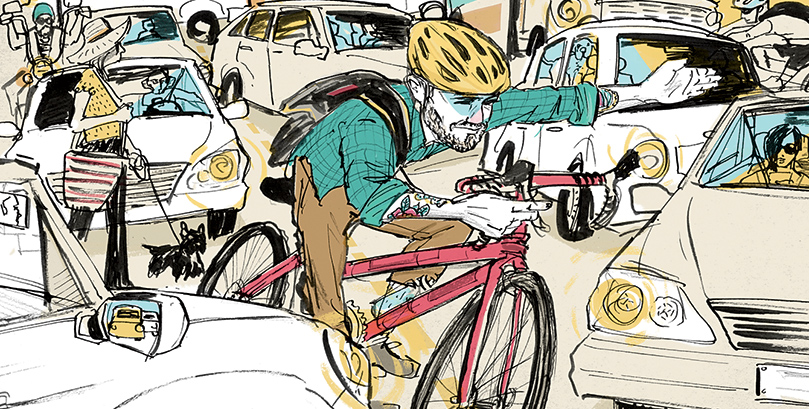

article by Bob Mionske
Few people on the road invoke my ire faster than drivers who neglect to use their turn signals. It’s simple: If you are turning, let everyone know. The roads are safer when drivers communicate their intentions; sudden stops and unannounced lane changes lead to accidents.
Cyclists are frequently guilty of the same offense. Just like drivers, we’re legally required to signal our turns and we should lead by example. But unlike cars, our bikes lack blinkers and brake lights. This means we need to alert others the old-fashioned way: with our hands. The motions are simple and easy to perform, but not everyone knows when to use them. Here’s how to manage six tricky hand-signal situations.
Why are there two right-turn signals? Which should I use?
Hand signals were developed for drivers a century ago. All the original motions were designed to be made with your left hand because you can’t safely steer a car while reaching your right hand through the passenger-side window. But the system never made sense for cyclists. Thankfully, bike riders can now legally use their right hand to notify others of right turns. It’s the best way—it’s easier for you to remember, and more recognizable to motorists.
Do I signal when I change lanes?
Absolutely. It’s always a smart idea to notify drivers when moving into the road from the shoulder, or crossing lanes to make a turn—maybe there’s a hazard in your path or you want to make a left turn ahead.
What if there are no cars around?
Do it anyway. Some cyclists have been surprised to find a rider passing them on the right just as they were preparing to turn. (It’s illegal for cyclists to pass on the right, by the way.) Signaling will help prevent anyone from crashing into you.
If I’m stuck at an intersection, do I need to keep my hand out while I wait?
Nope. You just have to make your intention clear. A signal before you stop and another before you take off will suffice.
What about while I’m turning?
Most states require you to signal continuously for 100 feet before turning. This can be a problem for cyclists, who need both hands to control the bike. It can be especially tricky when potholes, train tracks, or other obstacles lie in your path. Fortunately, the law takes this into account and you can stop signaling if you need both hands to control your bike.
I need to stop. Is it better to signal or to keep both hands on my brakes?
Legally, you’re required to signal. But as when you’re turning, the law offers some flexibility. Skip the signal if you need to stop suddenly or if you risk losing control of your bike. In normal conditions, start slowing by applying your front and rear brakes. Then use your left hand to indicate you’re stopping while continuing to brake with your right.
Know Your Signs
Left turn; stopping or slowing; right turn.
Oregon lawyer and Bike Law founder Bob Mionske is a former Olympic and professional cyclist based in Portland, with a law practice that is exclusively focused on representing cyclists who have been injured by motorists, unsafe road conditions, or defective cycling products. With offices in Portland, Bob represents cyclists all over the State, from Salem, Corvallis, and Eugene to Medford, Ashland, and Pendleton.
There are lots of attorneys out there who will be glad to take a bicycle injury case. And every other kind of case they can find. Bob is different. Before he was an Oregon bike accident lawyer, Bob was an amateur and professional racing cyclist. Bob represented the United States at the 1988 and 1992 Olympics, and in several other international races. After finishing his last professional racing season for Team Saturn, Bob changed directions, and after graduating from law school in 1999, opened the first cyclist-only law office in the world. Bob coined the term “bicycle law” to describe his new law practice, before anybody had ever heard of such a thing. Since then, Bob has focused his entire career on representing injured cyclists.
Bob began writing Legally Speaking, the nation’s first “Bicycle Law” column, in 2002, and in 2007, wrote Bicycling & the Law, the first book for cyclists on their legal rights since the publication of The Road Rights of Wheelmen in 1895. Today, Bob continues to write on bicycle law and the rights of cyclists in his Road Rights column for Bicycling magazine.
You can follow Bob on the Bike Law Blog as well as his personal site, Bicycle Law.
Read Bob’s advice on what to do if you are involved in a bicycle accident in Oregon.
If you have been injured in an Oregon bike accident, by a defective bicycle product, or because of an unsafe road condition and would like to discuss your case with an Oregon bicycle accident attorney who gets cycling, Bob welcomes your call for a free consultation. He can be reached at bob@bikelaw.com and 844-531-7530.
If you would like Bike Law to come speak to your club or at your shop, please contact our Director of Outreach Lauren Wilborn at lauren@bikelaw.com.

